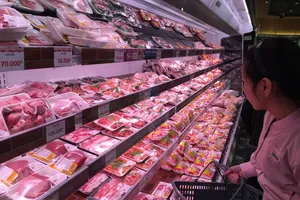
According to the Vietnam Steel Association (VSA), in the past eight months, steel production of all kinds merely reached 11.6 million tons, down 8.1 percent over the same period last year. Due to the influence of the pandemic, the selling volume of steel only reached 10.4 million tons, down 10.7 percent over the same period. Of which, steel export output of all kinds exceeded 1.8 million tons, down 24.6 percent over the same period. These are not very optimistic figures for enterprises in the steel industry.
Both consumption and production decreased, but the selling price of steel still increased. Regarding price movements, in mid-June, construction steel price surged by about VND200,000 per ton. Currently, it continues to increase further by about VND150,000 per ton, sending the prices of most steel products to over VND15 million per ton. The reason for this paradox is that the global raw material price has continuously climbed from the beginning of June until now. For instance, scrap increased by about US$30 per ton.
According to Mr. Nghiem Xuan Da, Chairman of the VSA, the global raw steel material price increased continuously, so the domestic steel price had to go up, although the Covid-19 pandemic has caused global consumption to weaken.
Similarly, information from the Vietnam Cement Association (VNCA) shows that the first half of 2020 recorded a 12-percent decrease in the industry’s consumption compared to the same period for the domestic consumption channel. The reason comes from the slowdown in construction activities. However, recently, the demand for cement has gradually recovered. Noticeably, the export volume maintained the growth rate thanks to the significant increase in demand from the Chinese market since the second quarter.
The latest statistics on the export situation of clinker and cement show that, in the past seven months, the cement industry has still brought in $732 million by exporting 19.5 million tons of cement. Compared to the same period last year, the export volume increased by nearly 2 million tons. This is driven by China's demand for infrastructure construction, which went up 35 percent year-on-year and accounted for 52 percent of total export volume.
It is forecasted that the cement consumption market in the next months will recover 3 percent over the same period, as the country accelerates the disbursement of public investment. In 2021, the demand will possibly restore by 3-5 percent thanks to the recovery of macroeconomics and infrastructure construction activities.
The Government has been speeding up the disbursement of public investment capital, so about VND700 trillion will be spent this year. Of which, VND200 trillion will be allocated for major infrastructure projects, such as the North-South Expressway and Tan Son Nhat Airport. This is also an opportunity for the domestic steel and cement industries to recover and accelerate their contribution to national economic growth. A good sign is that from July this year, public investment disbursement has improved.
It is forecasted that the consumption situation at the end of the year will be in a positive trend. It is estimated that demand in the second half of the year will recover and rally by 4-5 percent over the same period because of loosened social distancing policy and increased public investment, which is estimated to account for about 15 percent of steel consumption. Besides, Vietnam benefits from continuously-increasing steel demand in China.
According to the China Iron and Steel Association, China's steel consumption is estimated to increase by 40 million tons, equivalent to an increase of about 8 percent over the same period in the second half of this year and 2 percent for the whole year. Statistics show that in the first half of this year, Vietnam's steel exports to China have increased significantly, nearly 15 times higher, to 1.06 million tons, accounting for about 27 percent of Vietnam's total steel exports.
Meanwhile, according to the World Steel Association, the global steel demand is expected to recoup 4 percent in 2021. This will support the export channel of Vietnamese enterprises. At the same time, Vietnam also has a great opportunity to attract the flow of foreign direct investment (FDI) capital because of its ability to control the pandemic well and low labor costs. When FDI enterprises enter Vietnam, the demand for investment in factories and industrial parks will rise, leading to increasing demand for cement and construction steel.
However, to quickly regain the growth momentum as expected, the VSA and the VNCA proposed the Government to prioritize support by policies on finance, credit, interest rate cut, and debt rescheduling. At the same time, the Government should have directions and solutions in customs clearance, meeting the production needs of enterprises, but still complying with the regulations on pandemic prevention. The associations will also guide enterprises to restructure production, increase competitiveness through saving costs, improving corporate governance to lower cost prices, improve product quality, and find ways to diversify export markets to minimize losses.
Both consumption and production decreased, but the selling price of steel still increased. Regarding price movements, in mid-June, construction steel price surged by about VND200,000 per ton. Currently, it continues to increase further by about VND150,000 per ton, sending the prices of most steel products to over VND15 million per ton. The reason for this paradox is that the global raw material price has continuously climbed from the beginning of June until now. For instance, scrap increased by about US$30 per ton.
According to Mr. Nghiem Xuan Da, Chairman of the VSA, the global raw steel material price increased continuously, so the domestic steel price had to go up, although the Covid-19 pandemic has caused global consumption to weaken.
Similarly, information from the Vietnam Cement Association (VNCA) shows that the first half of 2020 recorded a 12-percent decrease in the industry’s consumption compared to the same period for the domestic consumption channel. The reason comes from the slowdown in construction activities. However, recently, the demand for cement has gradually recovered. Noticeably, the export volume maintained the growth rate thanks to the significant increase in demand from the Chinese market since the second quarter.
The latest statistics on the export situation of clinker and cement show that, in the past seven months, the cement industry has still brought in $732 million by exporting 19.5 million tons of cement. Compared to the same period last year, the export volume increased by nearly 2 million tons. This is driven by China's demand for infrastructure construction, which went up 35 percent year-on-year and accounted for 52 percent of total export volume.
It is forecasted that the cement consumption market in the next months will recover 3 percent over the same period, as the country accelerates the disbursement of public investment. In 2021, the demand will possibly restore by 3-5 percent thanks to the recovery of macroeconomics and infrastructure construction activities.
The Government has been speeding up the disbursement of public investment capital, so about VND700 trillion will be spent this year. Of which, VND200 trillion will be allocated for major infrastructure projects, such as the North-South Expressway and Tan Son Nhat Airport. This is also an opportunity for the domestic steel and cement industries to recover and accelerate their contribution to national economic growth. A good sign is that from July this year, public investment disbursement has improved.
It is forecasted that the consumption situation at the end of the year will be in a positive trend. It is estimated that demand in the second half of the year will recover and rally by 4-5 percent over the same period because of loosened social distancing policy and increased public investment, which is estimated to account for about 15 percent of steel consumption. Besides, Vietnam benefits from continuously-increasing steel demand in China.
According to the China Iron and Steel Association, China's steel consumption is estimated to increase by 40 million tons, equivalent to an increase of about 8 percent over the same period in the second half of this year and 2 percent for the whole year. Statistics show that in the first half of this year, Vietnam's steel exports to China have increased significantly, nearly 15 times higher, to 1.06 million tons, accounting for about 27 percent of Vietnam's total steel exports.
Meanwhile, according to the World Steel Association, the global steel demand is expected to recoup 4 percent in 2021. This will support the export channel of Vietnamese enterprises. At the same time, Vietnam also has a great opportunity to attract the flow of foreign direct investment (FDI) capital because of its ability to control the pandemic well and low labor costs. When FDI enterprises enter Vietnam, the demand for investment in factories and industrial parks will rise, leading to increasing demand for cement and construction steel.
However, to quickly regain the growth momentum as expected, the VSA and the VNCA proposed the Government to prioritize support by policies on finance, credit, interest rate cut, and debt rescheduling. At the same time, the Government should have directions and solutions in customs clearance, meeting the production needs of enterprises, but still complying with the regulations on pandemic prevention. The associations will also guide enterprises to restructure production, increase competitiveness through saving costs, improving corporate governance to lower cost prices, improve product quality, and find ways to diversify export markets to minimize losses.
























